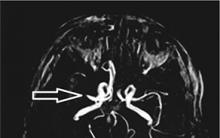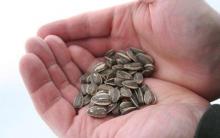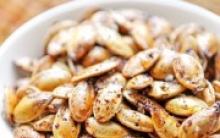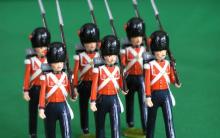Tatiana Kokorina
Target classes:
Continued acquaintance with the genre of painting « scenery» ,
Tasks:
Reinforce the concept « scenery» , learn to find scenery among reproductions of other genres and name its distinctive features;
Continue to teach how to distinguish between the background and the foreground, learn to notice the difference in the choice of paint color, size of an object, drawing details and level of presence at drawing object at different distances;
Continue to practice drawing different types trees, passing characteristics their structures, consolidate the skill paint wide lines throughout the pile and fine lines the tip of the brush;
Develop fine motor skills, imagination, Creative skills;
To cultivate aesthetic taste and interest in works of art.
Demo material: reproductions of paintings by artists - landscape painters on the topic« Autumn» , audio recording « Autumn» (from the series "Seasons" P. Tchaikovsky)
Handout: album sheet, brushes No. 5 and No. 2, gouache, napkins, palette, jars of water.
Methodical techniques: conversation-dialogue, viewing reproductions, productive activity, analysis of the results of activities.
Progress of the lesson:
The teacher reads a poem by I. Bunin
The forest looks like a painted tower
Lilac gold, crimson,
A beautiful, motley wall
Standing above a bright clearing.
Look at the reproductions of paintings in front of you, what do they depict? (trees, bushes, road, river, field, forest, sky, etc.) What time of year? How did you understand this? ( autumn, by the color of the leaves, grass, by what paints the artist chose for his work) And who can tell me, by the genre of painting, what is it?
If you see in the picture
River drawn,
Or spruce and white frost,
Or a garden and clouds,
Or a snowy plain
Or a field and a hut,
Required picture
Called - scenery.
What other genres of painting do you know? (portrait, still life)
Tell me why the trees are big here and small here? (because these trees are close to us, and these are far away) How else are they different?
(clear drawing branches, leaves, and in the distance, in one spot, trees drawn near ones are drawn at the bottom of the sheet, but trees in the distance are drawn higher and smaller in size)
Let us also turn into trees for a while
Fizminutka
We will become trees
Strong big
Legs are roots - let's spread them wider
The body is a mighty trunk
He sways a little
And with its sharp tip
Resting on the sky
Our hands are branches, our fingers are leaves
How will he come for the body? autumn
They'll fly apart in an instant

Now let's all become artists together and everyone will draw scenery.
Practical work.
During practical work music sounds « Autumn» (from the series "Seasons" P. Tchaikovsky)
1. Background work is done with watercolors


2. The palette mixes yellow and brown paint And is drawn forest in the background


3. Children, if desired, draw different trees in the foreground (birch, rowan, spruce, etc.)





In the middle of practical work is carried out
physical exercise or finger play
One two three four five
We will collect leaves.
Birch leaves, rowan leaves
Maple leaves, aspen leaves
We will collect oak leaves
To mom we'll take the autumn bouquet.
Final part.
Guys, tell me what we are today painted? (scenery)
Why are your trees big here, and here painted in one spot? (foreground and background)
Why is this picture called scenery? (it depicts trees, a forest)
True, if in the picture nature drawn, then these paintings belong to the genre of painting scenery.

Program content:
- Continue to master new unconventional drawing techniques. print with leaves, improve the ability to carefully use gouache, the desire to learn new things, develop creative abilities, fine motor skills, and expand your understanding of the world around you.
- To instill in children an interest in the process of drawing, to awaken interest in nature and careful attitude To her.
- Teach children to see, understand and name natural phenomena according to the seasons of the year during an excursion or walk.
Integration of educational areas : artistic and aesthetic development, social and communicative development
Materials: tinted album sheets A-3 (tinted with colored chalk), gouache, jars of water, plastic napkins, wet wipes, brushes No. 3, No. 5, stands for brushes, Chinese cabbage leaves different sizes.
- Looking at a corner of nature autumn leaves, compilation beautiful bouquets from leaves, observing the phenomenon of leaf fall while walking, drawing children’s attention to the fact that the leaves are different in color (red, yellow, green, brown).
- Reading fiction a story about autumn by M.M. Prishvin "Falling Leaves"
- Tell children about the artist I. Levitan.
- Learning songs, memorizing poems by M.Yu. Lermontov "Autumn".
- Application from dry leaves.
GCD move
- Hello guys! Today we will go on a journey through the forest, but which one you will now answer for yourself after listening to the poem:
Leaves are falling, falling -
In our garden the leaves are falling...
Yellow, red leaves
They curl and fly in the wind.
Birds fly south -
Geese, rooks, cranes.
This is the last flock
Flapping its wings in the distance.
Let's take each basket in our hands,
Let's go to the forest to pick mushrooms,
The stumps and paths smell
Delicious autumn mushroom
M. Iversen
- Guys, did you find out which forest we are going to?
Children's answers: “Autumn.”
- Yes, to the autumn fairy forest, a lot of interesting things await us there!
Teacher.
Guys, do you know what the autumn phenomenon is called when the leaves fall?
Children. This is leaf fall.
Teacher.
Right. Why does a tree shed its leaves in the fall? The cold weather is coming. In winter, tree growth usually slows down, there is not enough light and heat, and the leaves can freeze, as well as the whole tree. And then the leaves become unnecessary and even harmful. And also in winter it is very difficult for the branches to hold leaves and snow, the branches break due to such weight, the trees need to rest.
The teacher clarifies and complements the children’s answers. Teacher. Guys, I suggest you play.
Sounds
classical music
"Autumn" Outdoor game “Collect a bouquet” Objectives: improve the ability to distinguish leaves of different trees, develop observation and attention.
Progress of the game: children stand in a circle, leaves lie around the entire perimeter
play area , thereby reminding us of leaf fall. Children run around to the music. The music stops, each child chooses a piece of paper. Children make an autumn bouquet with leaves from the same tree, saying which tree the leaves come from. The game can be repeated 2-3 times. Teacher.
Children, look who it is?
A man comes out dressed as a mushroom picker, with a basket in his hands, there are mushrooms in the basket, he tells them that autumn is the most favorable time of year for picking mushrooms, and there are a lot of mushrooms growing in our grove, but they can understand which ones if guess
mushroom picker riddles.
If the children guess the riddle correctly, the mushroom picker takes the mushroom out of the basket and shows it to the children.
The brothers are sitting on a stump.
All with freckles, like boys.
These friendly guys
They are called... (honey mushrooms)
This cute little fungus
I chose a quiet corner.
Cut it with a knife,
After all, it’s edible... (russula)
If they are found in the forest,
They will immediately remember the fox.
Red-haired sisters
They are called... (chanterelles) Strong, dense, very stately,)
In a brown and smart hat. This is the pride of all forests! The real king of mushrooms! (
Porcini
Most
best mushroom
In the woods
I'm carrying it in a basket -
Strong, not wormy,
With a beautiful hat.
You will guess in a moment,
What's in the basket - ... (boletus)
Let it be without horns and without hooves,
He is very famous in the forest.
Doesn't jump like a colt
Golden... (Butter).
They don't know how to run at all
Lights in the grass turn yellow,
Without tails they are with their sister,
Even though they are called... (Chanterelles)
After the children have guessed the riddles, the mushroom picker thanks the children, says goodbye and leaves.
Teacher. In autumn, the leaves on the trees turn not only yellow, but also red and orange. This is due to weather conditions . If the autumn is rainy, the leaves will most likely be brown or dull yellow. But dry and sunny weather, on the contrary, provides a bright, rich color. Autumn in Russia has always been a time that has been sung by many writers, poets, artists and musicians. We are familiar with the artist Isaac Levitan. Isaac Levitan has a wonderful painting “».
Golden autumn
Children are invited to look at a reproduction of the painting. — The name of the painting speaks for itself, what time of year the artist depicted in it. The charm of the fiery golden and crimson colors in the painting “Golden Autumn” fascinates us. The landscape “Golden Autumn” depicts the most lyrical of the seasons. "It's a sad time! charm of the eyes! Your farewell beauty is pleasant to me,” Alexander Sergeevich Pushkin said about the golden autumn. Probably, it was these lines that the artist Isaac Levitan recalled while working on his famous landscapes . The artist understood that autumn is, first of all, a festival of colors, a farewell to summer. In nature, each season has its own unique charm. Looking at the painting “Golden Autumn”, a feeling of love for native nature
, which gives us unforgettable moments of high pleasure in beauty.
— Guys, Isaac Levitan painted his paintings in oils and watercolors, and you and I will paint our grove using Chinese cabbage leaves.
- To do this, we need to sit down in our seats and I will explain to you how we will do this.
Explanation.
Practical part. 1. To print a Chinese cabbage leaf, you can use gouache paint different color , (yellow, red, green, etc.). The paint should be applied to the side with veins using a brush; it is better to take a wider brush. then place the cabbage leaf on the paper with the colored side and press lightly with your palm. The result is an imprint - the crown of a tree. You can reuse an already painted sheet by applying a different color to it, then when mixing different colors
It will turn out very beautiful - like autumn.
2. Then take the leaf by the stem and carefully remove it from the surface of the paper sheet.
3. Children can complete their composition
Teacher. You and I have a wonderful autumn grove with beautiful trees
. You want to walk through such a grove and enjoy the warm autumn days.



Exhibition. Discussion of works. Open drawing lesson in the preparatory group. Subject "»
Autumn landscape
(non-traditional technique – leaf printing)
Compiled by: Kartashova Irina Albertovna
Prokopyevsk 2015
Goals:
consolidate the ability to use an unconventional technique in work – leaf printing; develop vision artistic image
, to form a sense of composition;
arouse interest in autumn natural phenomena
Tasks: create conditions for development creative imagination
and imagination;
cultivate emotional responsiveness to the beauty of autumn;
develop creative abilities, fine motor skills;
to develop in children perseverance and perseverance in achieving goals.
Materials: tinted album sheets, gouache, jars of water, napkins, brushes, autumn leaves, cotton swabs. Preliminary work: talking with children about autumn and autumn phenomena, reading and learning poems about autumn, guessing riddles, looking at illustrations depicting autumn nature, observing autumn nature
while walking.
Integration of educational areas: artistic creativity, cognitive.
GCD move:
Educator: Hello guys! Let's say hello to our guests!
Now guess the riddle:
The forest has stripped, the sky has cleared
This time of year is….. (autumn).
Let's look at the screen, what time of year is shown? What signs of autumn do you know? (children's answers)
Educator: Do you know poems about autumn? Let's remember and read. The poem begins…….
It's a sad time! Ouch charm!
Your farewell beauty is pleasant to me -
I love nature's lush wilting
Forests dressed in scarlet and gold.
In their canopy there is noise and fresh breath,
And the skies are covered with wavy darkness
And a rare ray of sunshine, and the first frosts
And distant threats of gray winter.
Autumn is coming in our park
Autumn gives gifts to everyone
Red beads - rowan,
Pink apron - aspen,
Yellow umbrella - poplars,
Autumn gives us fruits!
Leaf fall, leaf fall
Yellow leaves are flying
Yellow maple, yellow beech
Yellow circle in the sky of the sun.
Yellow yard, yellow house
The whole earth is yellow all around
Yellowness, yellowness
This means autumn is not spring.
Well done guys, you know, poems about autumn.
(There is a knock on the door, a chest appears unnoticed).
They grow in summer and fall in autumn. What is this? (children's answers) leaves.
What is the name of the autumn phenomenon when the leaves fall? (children's answers) Leaf fall
What color do the leaves turn in autumn? Red, orange, yellow, gold.
Educator: Look guys, the chest has opened (opens the chest, and there are autumn leaves, an album)
Guys, look what they sent us. Let's paint autumn landscapes together in an unusual way - by printing leaves.
Physical exercise.
We are autumn leaves
We sit on the branches
The wind blew and we flew
We were flying, we were flying
And they sat down on the ground again.
The wind came again
And I picked up all the leaves
Spun and flew
And they sat down quietly on the ground.
Educator: Now the time has come to turn into real artists to draw autumn landscapes.
Guys, look what the leaves look like? (On a small tree).
There is a large vein running through the middle of the leaf, what do you think it is?
(trunk). From the trunk, to different sides small veins pass through, what can they be compared to? (with branches).
Now we will draw in an unusual way, and our leaves will help us with this - we will print with them.
You need to take a piece of paper, apply paint with a brush, place it on your tinted sheet and press it without moving it. Take the next piece of paper, cover it with a different color, and print it in another place.
When the drawing is filled, you need to finish painting the tree trunks and branches with a thin brush. Using cotton swabs we will draw a lot of flying autumn leaves. Tell me guys, what else can we draw for our landscape?
Children: Sky, sun.
Educator: Well done guys! Everyone has done the job, let's use your beautiful drawings to make big album, and we will admire our drawings. I will give you two leaves, yellow and red, if you liked our activity, you will pick up the yellow leaf, and if not, then the red one.
And there’s a surprise left in the chest for you, let’s see what it is.
Thanks a lot, everyone!!!
Used Books:
Internet resources:
1. www. maam. ru
2. www. planetadetsva. net
3. Davydova G.N. Unconventional drawing techniques in kindergarten. Part 1 – M; “Publishing house Scriptorium 2003, 2007 - 80 p.
Goal: learn to reflect the signs of autumn in drawings, using non-traditional drawing techniques. Tasks: 1. Correctional educational: - fix names autumn months;— practice naming autumn signs;— learn to depict natural phenomena on paper;— learn to draw trees;— consolidate drawing techniques with a brush (the end of the brush);— continue to teach to depict natural phenomena in an unconventional way(poking technique). 2. Corrective and developmental: - develop coordination of movements, accompanying speech; - develop fine motor skills of the hands through finger game;— practice noun agreement singular with an adjective; - develop imagination; 3. Correctional and educational: - to cultivate an aesthetic perception of nature through the depiction of autumn signs; - to cultivate the ability to listen to both the teacher and their peers; - to cultivate a love of nature. Equipment: handkerchiefs according to the number of children, gouache according to the number of children (black, white, brown, blue), two leaves cut out of colored cardboard for each child, a foam rubber poke for each child. Lesson progress: 1. — Autumn is knocking on our door and inviting us to play.2. Game with leaves “Autumn” Leaves are falling, falling - Leaf is falling in our garden (children are spinning, raising their arms up, squatting) Yellow, red leaves are curling and flying in the wind. (Whirling again) Birds are flying south - Geese, rooks, cranes (they run in a circle, waving their arms) Now the last flock is waving its wings in the distance.3. Presentation “Autumn Walk”. I Slide: September. The leaves are slightly yellowed, the sun is shining and warming little, it is raining, the grass is withering, birds are flying to warmer regions, people are harvesting vegetables and fruits, people are dressing warmer. September - early autumn. (children pronounce the signs of autumn, the name of the month, say which month it is). II Slide: October. In October, the sun shines and warms less, it rains even more often, and it is even colder than in September. There are few leaves left on the trees. In October, all the grass is withered, the birds have flown to warmer climes, and the harvest of vegetables and fruits has already been harvested. In October, people dress warmer than in September. October - mid-autumn. (children pronounce the signs of autumn, the name of the month, say which month it is). III Slide: November. In November, the sun shines and warms even less, there are frosts, and the first snow falls. November - end of autumn. (children pronounce the signs of autumn, the name of the month, say what month it is).4. Examination of the sample.—What signs of autumn are depicted? (light snow, gloomy sky, no leaves on the trees). - Guys, these signs can be attributed to what period of autumn: the beginning, middle, end of autumn? - What kind of autumn is this? (late)5. Drawing techniques.-Look at the trees, how will we draw trees? (with the tip of the brush) -What kind of gouache do we need to mix to depict the sky? (add a drop of black to the white gouache) -How “magically” the snow is depicted, what do you guys think, how will we paint the snow? (poking method)6. A game for developing fine motor skills of the hands “First Snow”. One, two, three, four We made a snowball! Round, strong, very smooth (children take the handkerchief by two corners and use their fingers to collect the handkerchief in both palms) And not at all sweet! (they threaten with the index finger of either hand) Let's throw it up! (throws a handkerchief) We’ll catch two! (they catch the handkerchief with both hands) Let's drop three! (they drop it on the floor) And we’ll break it! (they shake the index finger of either hand).7. Independent drawing.8. Exhibition of works.











Consequences of tubal ligation during caesarean section
The benefits of sunflower seeds for the heart, hair and nerves
Why do my legs give way at the knees?
Name energy: how the patronymic influences fate and the birth program Name patronymic meaning character
First Chinese Emperor